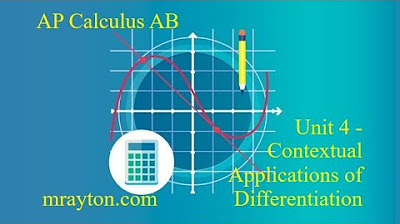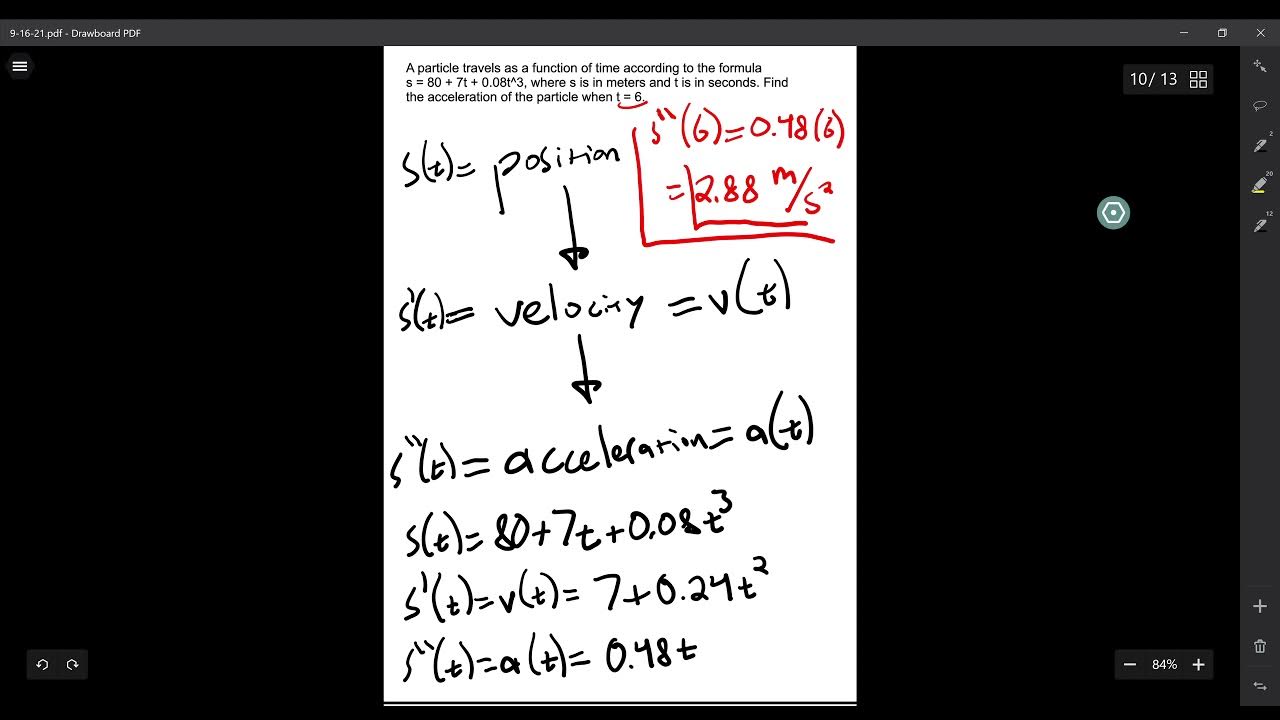Position, Velocity, Acceleration using Derivatives
TLDRThis video script delves into the relationship between position, velocity, and acceleration, explaining how derivatives and integrals are used to transition between these physical quantities. The core concept is that the derivative of position with respect to time gives velocity, and the derivative of velocity gives acceleration. The script illustrates this with a mechanical problem, showing how to calculate velocity and acceleration at a specific time using the given position equation. The explanation emphasizes the practical application of calculus in understanding motion, highlighting the significance of instantaneous rate of change in physics.
Takeaways
- 📌 The relationship between position, velocity, and acceleration is fundamental in understanding motion.
- 🔄 The derivative of position with respect to time gives the velocity.
- 📈 The derivative of velocity with respect to time yields the acceleration.
- 🅰️ Position is often abbreviated as s(T), where T represents time.
- 🚀 Velocity has a sign indicating direction (positive for right or forward, negative for left or backward).
- 🛤️ Speed is the absolute value of velocity and is always positive.
- 📶 To find the velocity at a specific time, substitute that time into the velocity equation derived from the position function.
- 🏎️ Acceleration is found by taking the derivative of the velocity function, which is the second derivative of the position function.
- 📌 An example motion equation is s = 5T^3 + 3T + 8, where T is in seconds and s in meters.
- 🕒 To calculate the velocity after two seconds, derive the position function and substitute T = 2 into the derivative.
- 🌪️ The acceleration after two seconds can be found by taking the derivative of the velocity function and substituting T = 2.
Q & A
What is the relationship between position, velocity, and acceleration?
-The derivative of position with respect to time gives you velocity, and the derivative of velocity with respect to time gives you acceleration.
How is velocity represented in terms of position?
-Velocity is represented by taking the first derivative of the position function with respect to time.
What does the sign of velocity indicate?
-The sign of velocity indicates the direction of motion. Positive velocity indicates movement in the positive direction, while negative velocity indicates movement in the opposite direction.
How can you find the instantaneous rate of change of velocity?
-You can find the instantaneous rate of change of velocity by taking the derivative of the velocity function, which gives you the acceleration.
What is the equation for the displacement of a particle given in the example?
-The equation for the displacement of a particle is s = 5T^3 + 3T + 8, where T is measured in seconds.
What is the velocity of the particle after 2 seconds according to the given equation?
-The velocity after 2 seconds is 15(2)^2 + 3 = 60 + 3 = 63 meters per second.
How can you find out when the velocity equals a specific value, such as 100 meters per second?
-You would set the velocity equation equal to the desired velocity value (100 in this case) and solve for the time variable T.
What is the acceleration of the particle after 2 seconds according to the given equation?
-The acceleration after 2 seconds is 15(2)^2 + 3 = 30(2) + 3 = 60 meters per second squared.
Why is understanding the relationship between position, velocity, and acceleration important?
-Understanding these relationships is crucial in kinematics and dynamics as they provide insights into the motion of an object, including its speed, direction, and how these change over time.
What does the derivative quantify?
-The derivative quantifies the instantaneous rate of change of a function with respect to its variable, which in the context of motion, can represent changes in position, velocity, or acceleration.
How does the concept of derivatives relate to real-world physical situations like driving a car?
-The derivative in the context of driving relates to the rate at which distance changes, which is the speed of the car. The rate of change of speed over time gives acceleration, providing insights into how quickly the car's speed is changing.
What is the antiderivative of acceleration with respect to time?
-The antiderivative of acceleration with respect to time gives you the velocity function, and taking the antiderivative of the velocity function gives you the position function.
Outlines
📐 Understanding Position, Velocity, and Acceleration
This paragraph introduces the fundamental concepts of position, velocity, and acceleration, and their interrelationships. It explains that the derivative of a position function represents velocity, and further differentiating velocity yields acceleration. The explanation includes the use of mathematical notation (e.g., s(t) for position) and emphasizes the importance of the sign in velocity to indicate direction. The paragraph also touches on the concept of speed, which is the absolute value of velocity, and sets up a context for a mechanical problem involving calculating velocity and acceleration from a given position function.
🔢 Calculating Velocity and Acceleration from Position
The second paragraph delves into the practical application of the concepts introduced earlier. It presents a specific problem where the displacement of a particle is given by the equation s = 5t^3 + 3t + 8, and the task is to find the velocity and acceleration after two seconds. The paragraph outlines the process of taking derivatives of the position function to obtain the velocity function and then another derivative to find the acceleration. It provides a step-by-step calculation, including plugging in the value of time (t=2s) to get the numerical results for velocity (63 m/s) and acceleration (60 m/s^2). The paragraph also briefly discusses how to find when the velocity reaches a certain value, such as 100 m/s, by solving the velocity equation for time.
Mindmap
Keywords
💡position
💡velocity
💡acceleration
💡derivative
💡displacement
💡instantaneous rate of change
💡speed
💡kinematics
💡mechanical problem
💡antiderivative
💡slope of the tangent line
Highlights
The relationship between position, velocity, and acceleration is based on derivatives.
The derivative of position gives you an equation that describes velocity.
The derivative of velocity provides the acceleration.
Position is often abbreviated as s(T), representing a function of time.
Velocity has a sign associated with it, indicating direction of movement.
Speed is always positive, as it is the absolute value of velocity.
The second derivative of the position function gives the acceleration.
A mechanical problem is used to illustrate the concepts with a particle moving in a straight line.
The equation of motion for the particle is s = 5T^3 + 3T + 8, where T is time in seconds.
The velocity after two seconds is calculated by taking the derivative of the position function and plugging in T = 2.
The velocity is found to be 63 meters per second after two seconds.
To find when the velocity equals 100 meters per second, the velocity equation is set to 100 and solved for T.
The acceleration is calculated by taking the derivative of the velocity function.
The acceleration after two seconds is found to be 60 meters per second squared.
Derivatives quantify the instantaneous rate of change, which can be useful in physical situations.
The speedometer in a car shows the instantaneous rate of change of distance, which is speed.
The slope of the tangent line in a position-time graph represents velocity.
Understanding the physical meaning behind derivatives makes calculus more useful and less mechanical.
Transcripts
Browse More Related Video
5.0 / 5 (0 votes)
Thanks for rating:





